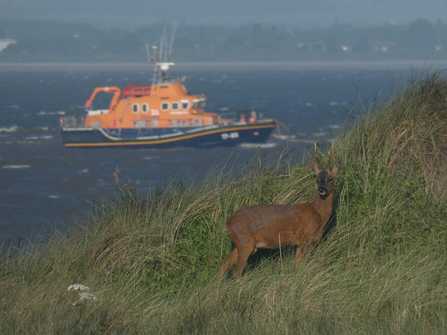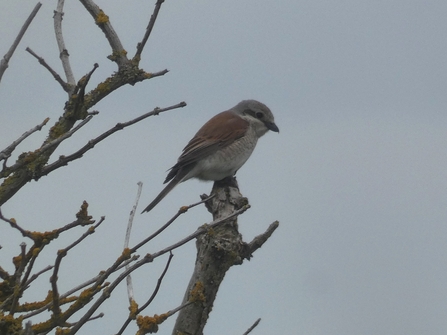In October 2021, I was given the chance to join Yorkshire Wildlife Trust as a Practical Conservation Trainee at Spurn National Nature Reserve. With my boots firmly in the ground as a watcher of my local patch in Milton Keynes, recording birds, odonata and carrying out yearly butterfly transects, the idea of travelling 200 miles to spend most of a year in a totally new environment was initially very daunting but after some lengthy consideration, I decided it was an opportunity that was too good to miss.
Life as a Practical Conservation Trainee at Spurn
Harry Appleyard

Spurn is located at the tip of the east Yorkshire coast, about 45 minutes’ drive from the city of Hull. One of the country’s most renowned sites for birding, it delivers scarcities and rarities on a regular basis. The habitats on both land and sea are closely monitored by a dedicated band of local birders and recorders.
While it may be as close to the sea as you can get, Spurn’s traineeships are tailored to develop highly-transferrable knowledge and practical skills that can be taken to a wide variety of landscapes. Trainees are quickly given hands-on experience with a variety of tasks including livestock management, site maintenance and use of reserve vehicles. The everchanging washover is a good place to practice off-road driving; once holding a road connecting the northern half of the reserve to the southern half, it is now only accessible by the Spurn reserve team and the RNLI, and extremely variable in accessibility day-to-day.
Brown-tail Moth webs. Photo credit: Harry Appleyard
Some of Spurn’s livestock include Hebridean sheep and the popular Highland cattle, which are frequently checked and moved across the site between autumn and early spring. Their grazing helps to prepare the reserve’s wildflower meadows for spring and summer, protects root systems which could be damaged by machinery, and supports ground-nesting bird species including meadow pipits and skylarks.
A large portion of the autumn and winter work involves site maintenance, trimming vegetation near the footpaths and increasing access to the reserve’s features. There is also the population control of brown-tailed moths due to their natural predators not yet having moved northwards; a species that has had a strong foothold on the reserve for many years and which present a health risk to the general public as well as preventing the growth of berries.
A more exclusive task for Spurn over the past few months has been eelgrass restoration. Now present in just a small portion of the Humber after a significant decline many years ago, the Yorkshire Wildlife Trust’s Marine Team have been hard at work to get this unique species kickstarted once more. Some of the rainier days of the autumn were spent making seagrass bags, small sacks of hessian with the tiny seeds and sediment wrapped inside, ready to be planted at the edge of the Humber at low tide.
A snow-bunting. Photo credit: Harry Appleyard
Recently, I have been helping to install electric fencing on the reserve’s thinnest section of beach, the washover, protecting ringed plovers and oystercatchers from ground-based predators and preventing human disturbance. Carrying out beach patrols in this area has been a good way of interacting with visitors, raising awareness of ground-nesting shorebirds, talking about other recent finds on-site with the bonus of possibly seeing a seal, porpoise or even a dolphin!
I can happily say that applying for this traineeship was one of the best decisions I’ve ever made. It’s already given me so much knowledge and new skills that I never initially saw myself gaining! With thanks to on-site LANTRA training and practice with Spurn’s reserve team, I recently passed my Brushcutter training, meaning I and the other volunteers who participated will be gaining a license for using them across other parks and reserves nationally.
It's also been a massive eyeopener to the everyday running of a nature reserve throughout the year in so many ways – seeing how tasks are co-ordinated around weather and tide times, how events are planned and promoted and the interactions between regional teams within Yorkshire Wildlife Trust. It’s an access-all-areas opportunity, so trainees are at the forefront of the fieldwork and behind-the-scenes projects at the reserve and heavily integrated with the rest of the team. There’s also the opportunity to partake in external training hosted by Yorkshire Wildlife Trust at other reserves in the county.

A red-backed shrike. Photo credit: Harry Appleyard
On days off you are free to your own devices but there is so much to explore and do across Spurn and its neighbouring reserve, Kilnsea Wetlands. Some of my favourite “firsts” from here have included brown shrike, red-backed shrike, Temminck’s stints, glaucous gulls, red-rumped swallows, and, just days after I started in October 2021, Britain’s 10th two-barred greenish warbler which lingered for several days by the Discovery Centre.
I cannot thank Yorkshire Wildlife Trust enough for giving me this amazing opportunity. It’s been well worthwhile for gaining confidence in travelling further afield and working in new and exciting parts of the country. The ride isn’t over yet though, and I can’t wait to see what the next few months bring!
